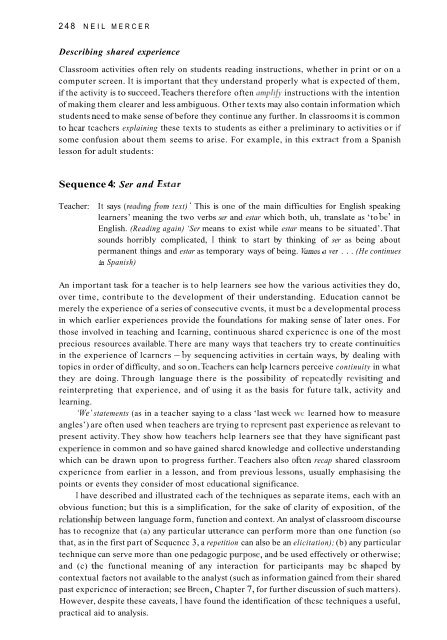English Language Teaching in its Social Context
English Language Teaching in its Social Context
English Language Teaching in its Social Context
You also want an ePaper? Increase the reach of your titles
YUMPU automatically turns print PDFs into web optimized ePapers that Google loves.
248 NEIL MERCERDescrib<strong>in</strong>g shared experienceClassroom activities often rely on students read<strong>in</strong>g <strong>in</strong>structions, whether <strong>in</strong> pr<strong>in</strong>t or on acomputer screen. It is important that thcy understand properly what is expected of them,if the activity is to succeed.Teachers therefore often amp1~<strong>in</strong>structions with the <strong>in</strong>tentionof mak<strong>in</strong>g them clearer and less ambiguous. Other texts may also conta<strong>in</strong> <strong>in</strong>formation whichstudents necd to make sense of before they cont<strong>in</strong>ue any further. In classrooms it is commonto hear tcachcrs expla<strong>in</strong><strong>in</strong>g these texts to students as either a prelim<strong>in</strong>ary to activities or ifsome confusion about them seems to arise. For example, <strong>in</strong> this cxtract from a Spanishlesson for adult students:Sequence 4: Ser and EstarTeacher: It says (read<strong>in</strong>gfrom text) ‘ This is one of the ma<strong>in</strong> difficulties for <strong>English</strong> speak<strong>in</strong>glearners’ mean<strong>in</strong>g the two verbs ser and estar which both, uh, translate as ‘to be’ <strong>in</strong><strong>English</strong>. (Read<strong>in</strong>g aga<strong>in</strong>) ‘Ser means to exist while estar means to be situated’. Thatsounds horribly complicated, I th<strong>in</strong>k to start by th<strong>in</strong>k<strong>in</strong>g of ser as be<strong>in</strong>g aboutpermanent th<strong>in</strong>gs and estar as temporary ways of be<strong>in</strong>g. Vamos u ver . . . (He cont<strong>in</strong>ues<strong>in</strong> Spanish)An important task for a teacher is to help learners see how the various activities they do,over time, contribute to the development of their understand<strong>in</strong>g. Education cannot bemerely the experience of a series of consecutive cvcnts, it must bc a developmental process<strong>in</strong> which earlier experiences provide the foundations for mak<strong>in</strong>g sense of later ones. Forthose <strong>in</strong>volved <strong>in</strong> teach<strong>in</strong>g and Icarn<strong>in</strong>g, cont<strong>in</strong>uous sharcd cxpericncc is one of the mostprecious resources available. There are many ways that teachers try to create cont<strong>in</strong>uitics<strong>in</strong> the experience of lcarncrs ~ by sequenc<strong>in</strong>g activities <strong>in</strong> certa<strong>in</strong> ways, by deal<strong>in</strong>g withtopics <strong>in</strong> order of difficulty, and so on.Tcachcrs can hclp lcarncrs perceive cont<strong>in</strong>uity <strong>in</strong> whatthey are do<strong>in</strong>g. Through language there is the possibility of rcpcatcdly rcvisit<strong>in</strong>g andre<strong>in</strong>terpret<strong>in</strong>g that experience, and of us<strong>in</strong>g it as the basis for future talk, activity andlearn<strong>in</strong>g.‘We’ statements (as <strong>in</strong> a teacher say<strong>in</strong>g to a class ‘last week we learned how to measureangles’) are often used when teachers are try<strong>in</strong>g to rcprcsent past experience as relevant topresent activity. They show how teachcrs hclp learners see that they have significant pastcxperience <strong>in</strong> common and so have ga<strong>in</strong>ed sharcd knowledge and collective understand<strong>in</strong>gwhich can be drawn upon to progress further. Teachers also often recap shared classroomcxpericnce from earlier <strong>in</strong> a lesson, and from previous Icssons, usually emphasis<strong>in</strong>g thepo<strong>in</strong>ts or events they consider of most cducational significance.I have described and illustrated cach of the techniques as separate items, each with anobvious function; but this is a simplification, for the sake of clarity of exposition, of therclationship between language form, function and context. An analyst of classroom discoursehas to recognize that (a) any particular utterance can perform more than one function (sothat, as <strong>in</strong> the first part of Scqucncc 3, a repetition can also be an elicitation); (b) any particulartechnique can serve more than one pedagogic purposc, and be used effectively or otherwise;and (c) the functional mean<strong>in</strong>g of any <strong>in</strong>teraction for participants may bc shapcd bycontextual factors not available to the analyst (such as <strong>in</strong>formation ga<strong>in</strong>cd from their sharedpast expcricncc of <strong>in</strong>teraction; see Brccn, Chapter 7, for further discussion of such matters).However, despite these caveats, I have found the identification of thcsc techniques a useful,practical aid to analysis.












